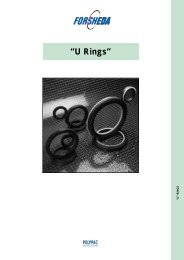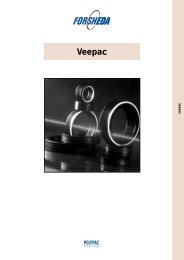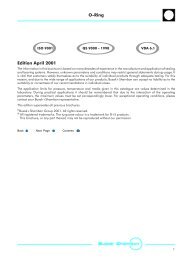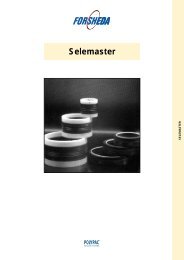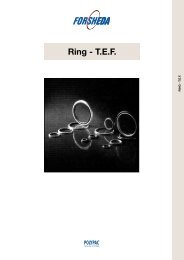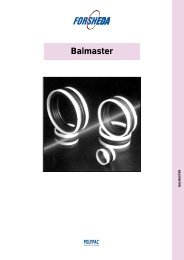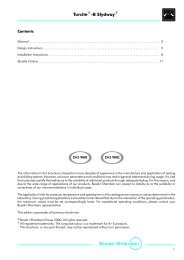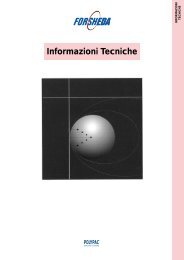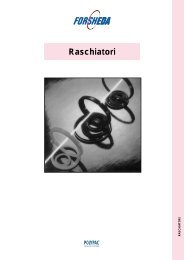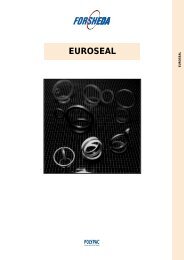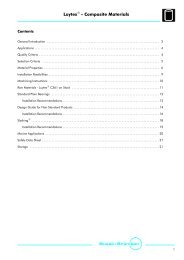Rotary Seals - Dilanda.it
Rotary Seals - Dilanda.it
Rotary Seals - Dilanda.it
Create successful ePaper yourself
Turn your PDF publications into a flip-book with our unique Google optimized e-Paper software.
Radial Oil Seal<br />
n Shaft and housing design<br />
Shaft<br />
Surface finish, hardness and machining methods<br />
The shaft design is of v<strong>it</strong>al significance for the performance<br />
as well as for the useful life of the seal (see Figure 3). As a<br />
basic principle, the hardness of the shaft should be higher<br />
for increasing peripheral speeds. The Standard DIN 3760<br />
specifies that the shaft must be hardened at least 45 HRC.<br />
As the peripheral speeds increase, the hardness must<br />
be increased and at 10 m/s a hardness of 60 HRC is<br />
required. The choice of a su<strong>it</strong>able hardness is dependent<br />
not only on the peripheral speed but also on such factors as<br />
lubrication and the presence of abrasive particles. Poor<br />
lubrication and difficult environmental cond<strong>it</strong>ions require<br />
a higher hardness of the shaft. DIN 3760 specifies a<br />
surface roughness of Rt=1 μm to4μm. Laboratory tests<br />
have however proved that the most su<strong>it</strong>able roughness is<br />
Rt=2 μm (Ra=0.3 μm). Rougher as well as smoother surfaces<br />
generate higher friction, resulting in increased<br />
temperature and wear. We suggest a surface roughness<br />
of Rt=2-3 μm (Ra=0.3-0.8 μm).<br />
Measurements of friction and temperature have also<br />
shown that grinding of the shaft is the best method of<br />
machining. However spiral grinding marks may cause a<br />
pumping effect and leakage and plunge grinding should<br />
therefore be applied, during which even ratios between<br />
grinding wheel speed and work-piece should be avoided.<br />
Polishing of the shaft surface w<strong>it</strong>h polishing cloth produces<br />
a surface which causes higher friction and heat generated<br />
as compared w<strong>it</strong>h plunge grinding. In certain cases <strong>it</strong><br />
maybe impossible to provide the necessary hardness,<br />
surface finish and corrosion resistance of the shaft. This<br />
problem can be solved by f<strong>it</strong>ting a separate sleeve onto the<br />
shaft. If wear should occur, only the sleeve need to be<br />
replaced (see the chapter Shaft Repair K<strong>it</strong>).<br />
Shaft run out<br />
Shaft run out should as far as possible be avoided or kept<br />
w<strong>it</strong>hin a minimum. At higher speeds there is a risk that the<br />
inertia of the sealing lip prevents <strong>it</strong> from following the<br />
shaft movement. The seal must be located next to the<br />
bearing and the bearing play be maintained at the<br />
minimum value possible. See Figure 13.<br />
Shaft run out, mm<br />
0.4<br />
0.3<br />
0.2<br />
0.1<br />
0<br />
Figure 13<br />
VMQ<br />
NBR-ACM-FKM<br />
1000 2000 3000 4000 5000 6000 7000<br />
Shaft speed, min -1<br />
Shaft run out<br />
Eccentric<strong>it</strong>y<br />
Eccentric<strong>it</strong>y between shaft and housing bore centers<br />
should be avoided in order to eliminate unilateral load of<br />
the lip. See Figure 14.<br />
Eccentric<strong>it</strong>y, mm<br />
0.4<br />
0.3<br />
0.2<br />
0.1<br />
0<br />
25<br />
50<br />
75<br />
100<br />
125<br />
150<br />
175<br />
200<br />
225<br />
250<br />
275<br />
Shaft diameter, mm up to 500<br />
Figure 14<br />
Eccentric<strong>it</strong>y<br />
Latest information available at www.busakshamban.com<br />
Ed<strong>it</strong>ion April 2006<br />
27



